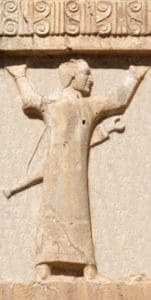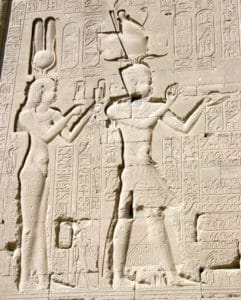
The Thirtieth Dynasty was the last native ruling dynasty during the Pharaonic epoch. It fell to the Persians again in 343 BCE after the last native Pharaoh, King Nectanebo II, was defeated in battle. This Thirty-first Dynasty of Egypt, however, did not last long, for the Persians were toppled several decades later by Alexander the Great. The Macedonian Greek general of Alexander, Ptolemy I Soter, founded the Ptolemaic dynasty.
Ptolemaic and Roman Egypt:
The Ptolemaic Kingdom was a powerful Hellenistic state, extending from southern Syria in the east, to Cyrene to the west, and south to the frontier with Nubia. Alexandria became the capital city and a center of Greek culture and trade. To gain recognition by the native Egyptian populace, they named themselves as the successors to the Pharaohs. The later Ptolemies took on Egyptian traditions, had themselves portrayed on public monuments in Egyptian style and dress, and participated in Egyptian religious life.

The last ruler from the Ptolemaic line was Cleopatra VII, who committed suicide following the burial of her lover Mark Antony who had died in her arms (from a self-inflicted stab wound), after Octavian had captured Alexandria and her mercenary forces had fled. The Ptolemies faced rebellions of native Egyptians often caused by an unwanted regime and were involved in foreign and civil wars that led to the decline of the kingdom and its annexation by Rome. Nevertheless, Hellenistic culture continued to thrive in Egypt well after the Muslim conquest.

Christianity was brought to Egypt by Saint Mark the Evangelist in the 1st century. Diocletian’s reign (284–305 CE) marked the transition from the Roman to the Byzantine era in Egypt, when a great number of Egyptian Christians were persecuted. The New Testament had by then been translated into Egyptian. After the Council of Chalcedon in CE 451, a distinct Egyptian Coptic Church was firmly established.
Middle Ages (7th century – 1517):
The Byzantines were able to regain control of the country after a brief Sasanian Persian invasion early in the 7th century amidst the Byzantine–Sasanian War of 602–628 during which they established a new short-lived province for ten years known as Sasanian Egypt, until 639–42, when Egypt was invaded and conquered by the Islamic Empire by the Muslim Arabs. When they defeated the Byzantine armies in Egypt, the Arabs brought Sunni Islam to the country. Early in this period, Egyptians began to blend their new faith with indigenous beliefs and practices, leading to various Sufi orders that have flourished to this day. These earlier rites had survived the period of Coptic Christianity.

In 639 an army of some 4,000 men were sent against Egypt by the second caliph, Umar, under the command of Amr ibn al-As. This army was joined by another 5,000 men in 640 and defeated a Byzantine army at the battle of Heliopolis. Amr next proceeded in the direction of Alexandria, which was surrendered to him by a treaty signed on 8 November 641. Alexandria was regained for the Byzantine Empire in 645 but was retaken by Amr in 646. In 654 an invasion fleet sent by Constans II was repulsed. From that time no serious effort was made by the Byzantines to regain possession of the country.
